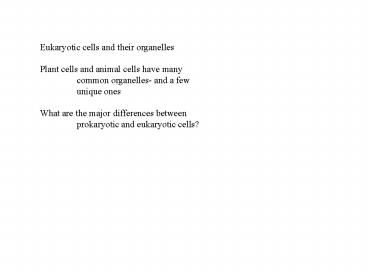Eukaryotic cells and their organelles - PowerPoint PPT Presentation
1 / 42
Title:
Eukaryotic cells and their organelles
Description:
Eukaryotic cells and their organelles. Plant cells and animal cells have many ... Contractile. Food (in variety of cells) Central vacuole (tonoplast membrane) ... – PowerPoint PPT presentation
Number of Views:341
Avg rating:3.0/5.0
Title: Eukaryotic cells and their organelles
1
Eukaryotic cells and their organelles Plant
cells and animal cells have many common
organelles- and a few unique ones What are the
major differences between prokaryotic and
eukaryotic cells?
2
Presence of a nucleus Internal membrane system
produces special compartments for cell
functions Tubules and filaments involved in
motility Exocytosis and endocytosis Chromosome
formation Mitosis vs. cell fission RNA
processing
3
(No Transcript)
4
(No Transcript)
5
The nucleus double membrane fused by nuclear
pores pores are lined by pore complexes regulat
e movement of mRNA, ribosomes, enzymes, etc.
6
(No Transcript)
7
Ribosomes- free or attached to endoplasmic reticu
lum Free ribosomes produce intracellular
proteins (structural and enzymes) Attached
ribosome-secreted
8
(No Transcript)
9
Endoplasmic reticulum is rough or smooth Rough
ER is covered with ribosomes Ribosomes
synthesize polypeptide chains processed and
formed in RER Proteins are modified in the
ER glycosylation enzymes Secreted and plasma
membrane proteins are made in the RER
10
(No Transcript)
11
(No Transcript)
12
(No Transcript)
13
Smooth ER Synthesis of lipids and
steroids Glycogen synthesis in liver Drug
detoxification , esp. in liver SER synthesis is
inducible (so is RER) Muscle cells-
sarcoplasmic reticulum sequesters and releases
calcium
14
The Golgi apparatus receives proteins from the
ER Golgi is oriented cis-trans Vesicles
transport proteins from RER and fuse Vesicles
bud off from Golgi to transport proteins to
their destination Processing continues in Golgi
glycosylation, phosphate groups, etc. Can
synthesize (and process) saccharides
15
(No Transcript)
16
Mitochondria and chloroplasts convert energy to
forms that cells can use Have their own
ribosomes and DNA inherited from maternal
parent in sexual reproduction Have double
membranes Mitochondria are found in most
eukaryotic cells (not RBCs) Chloroplasts are
found in photosynthetic tissues- plants and
algae
17
(No Transcript)
18
(No Transcript)
19
Chloroplasts are a type of plastid Amyloplasts
store starch Chromoplasts store pigment
20
Lysosomes contain hydrolytic enzymes that digest
large biomolecules Enzymes are synthesized
similarly to secreted proteins tagged as
lysosomal with mannose-6-phosphate Packaged
into vesicles and transported to endosomes Dis
covered by Christian de Duve, 1950s
21
Digestive function was observed before lysosomes
were DeDuve was looking for an enzyme
involved in carbohydrate metabolism
(location in liver) Used acid phosphatase as
control enzyme Used differential centrifugation
to find the former enzyme (in microsomes)
22
Findings with acid phosphatase Activity
increased after a few days Acid phosphatase
seemed to pellet with mito- chondrial portion.
Activity increased upon exposure to
detergents (I.e., enzyme was within a
membrane-bound particle) Slower centrifugation
showed that activity was NOT associated with
mitochondrion Acid phosphatase was associated
with other hydrolytic enzymes
23
Hypothesis enzymes were packaged together in
membrane-bound organelle Presence of lysosomes
later confirmed by electron microscopy
24
(No Transcript)
25
(No Transcript)
26
Peroxisomes Animal cells Detoxification, esp.
in liver and kidney Breakdown of fatty acids
(small ones can be handled in mitochondria, but
slowly) adrenoleukodystrophy- sex-linked enzyme
deficiency fatal Glyoxysomes (seeds) store fat
and contain enzymes that convert it to sugar
27
Leaf peroxisomes photorespiration (along with
mitochondria and chloroplasts) tends to occur
in hot dry conditions
28
Vacuoles especially important in
aquatic organisms Contractile Food (in variety
of cells) Central vacuole (tonoplast
membrane) may be most conspicuous part of plant
cell
29
(No Transcript)
30
Cytoskeleton Organization and motility of
cell cilia and flagella movement of organelles
within cells cytoplasmic streaming
31
(No Transcript)
32
(No Transcript)
33
Microfilaments (actin)- movement Support
structure just inside cell membrane Muscle
contraction sliding filaments Pseudopodia
34
(No Transcript)
35
Intermediate harder to classify Important for
stability rather than movement
36
Cell wall Plants, bacteria, fungi, some
protists Bacteria- peptidoglycan Fungi- chitin
37
(No Transcript)
38
Extracellular matrix Support Adhesion Movement R
egulation
39
(No Transcript)
40
Interactions involved in adhesion Integrin-fibron
ectin L-selectin-mucin (proteoglycan)
41
Intercellular junctions Organzie cells into
tissues Enables these cells to communicate
with each other Movement of water and
nutrients Electrical/chemical signals Plasmodesm
ata in plants In animals
42
(No Transcript)































